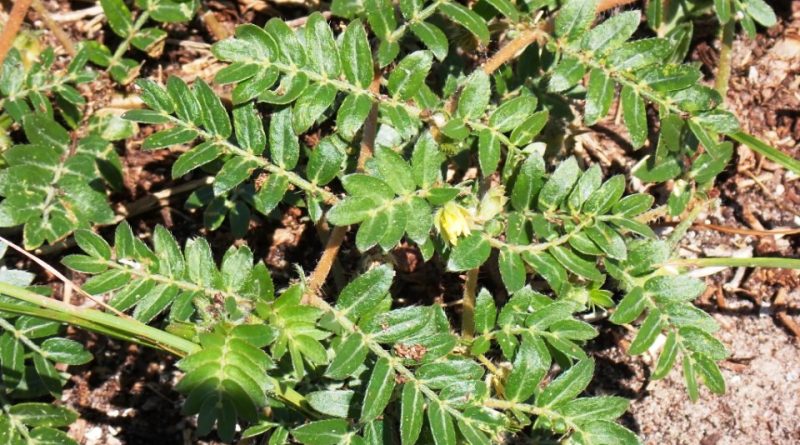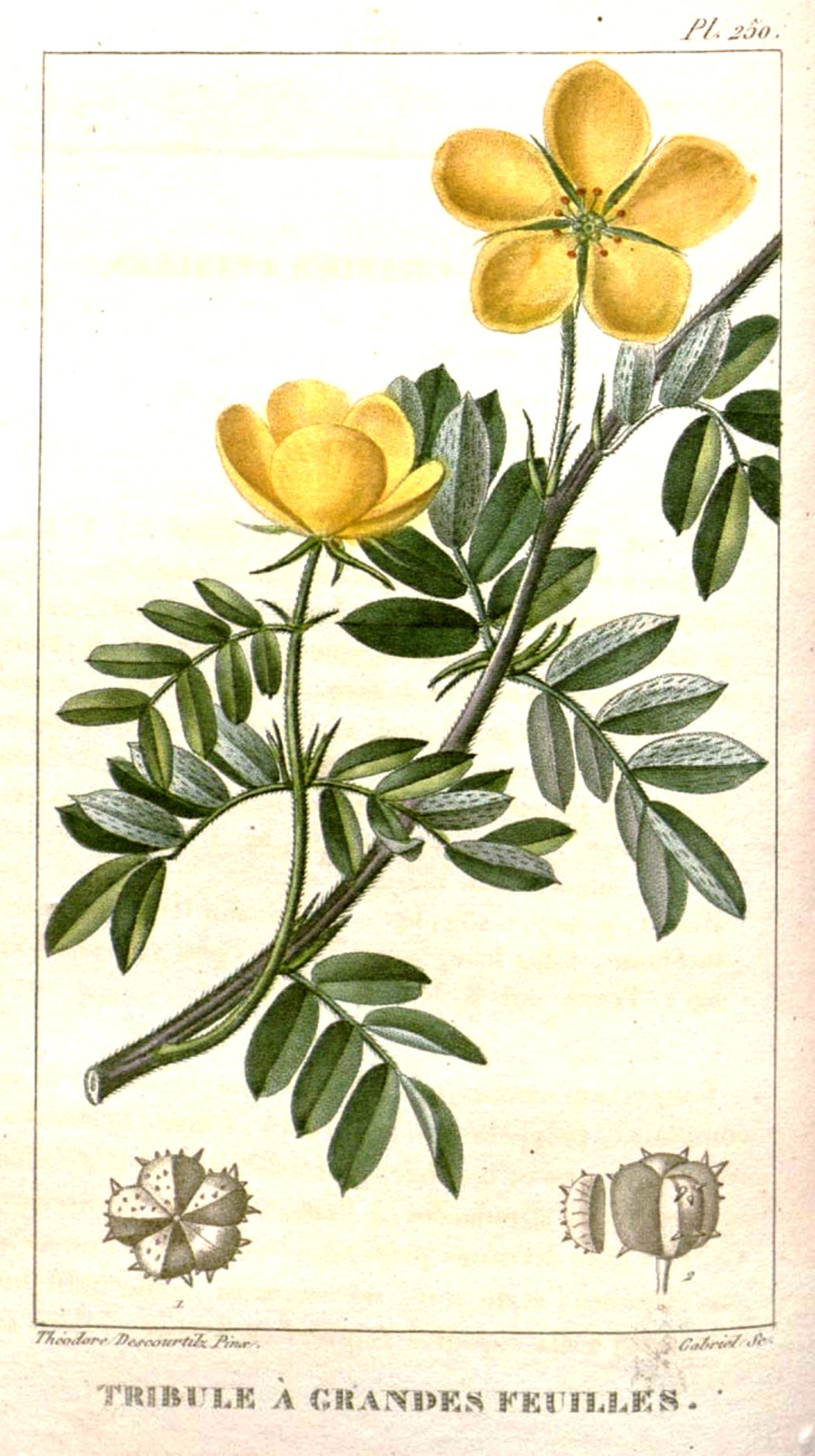Tribulus terrestris
Tribulus terrestris
Caltrop (Tribulus terrestris L., 1753) is a herbaceous species belonging to the Zygophyllaceae family.
Systematics –
From a systematic point of view it belongs to:
Eukaryota Domain,
Kingdom Plantae,
Subarign Tracheobionta,
Spermatophyta superdivision,
Magnoliophyta Division,
Magnoliopsida class,
Subclass Rosidae,
Superorder Rosanae,
Sapindales Order,
Zygophyllaceae family,
Tribuleae tribe,
Genus Tribulus,
T. terrestris species.
The terms are synonymous:
– Hedysarum uniflorum Lapeyr.;
– Tribulus acanthococcus F.Muell.;
– Tribulus albescens Schltr.;
– Tribulus albescens Schltr. ex Dinter;
– Tribulus albus Poir.;
– Tribulus bicornutus Fisch. & C.A.Mey.;
– Tribulus bimucronatus Kralik, 1849;
– Tribulus gussonei Tod. & Pirain.;
– Tribulus gussonei Tod. & Pirain. ex Parl.;
– Tribulus humifusus Schum. & Thonn.;
– Tribulus kotschyanus Boiss.;
– Tribulus lanuginosus var. microcarpus Chiov.;
– Tribulus maximus var. roseus Kuntze;
– Tribulus micans Welw.;
– Tribulus murex C.Presl;
– Tribulus murex Schltr.;
– Tribulus muricatus Stokes;
– Tribulus nogalensis Chiov.;
– Tribulus terrestris var. brachyceras Batt. & Trab.;
– Tribulus terrestris var. hispidissimus Sond.;
– Tribulus terrestris var. inermis Boiss.;
– Tribulus terrestris var. macrocarpus Rouy;
– Tribulus terrestris var. nogalensis Chiov..
Within this species, the following subspecies and varieties are recognized:
– Tribulus terrestris subsp. orientalis (A.Kern.) Dostál;
– Tribulus terrestris subsp. terrestris;
– Tribulus terrestris var. bicornutus (Fisch. & C.A.Mey.) Hadidi;
– Tribulus terrestris var. orientalis (A.Kern.) Beck;
– Tribulus terrestris var. rajasthanensis (Bhandari & V.S.Sharma) Hemaid & Jacob-Thomas;
– Tribulus terrestris var. robustus (Boiss. & Noë) Boiss.;
– Tribulus terrestris var. terrestris.
Etymology –
The term Tribulus comes from the Greek τρίβολος which means “water chestnut”, translated into Latin as tribulos. The Latin name tribulus originally referred to a pointed weapon, but already in classical times the word also meant this plant.
The specific epithet terrestris comes from the ground: for the creeping posture on the ground.
Geographic Distribution and Habitat –
The Caltrop is a plant present in various continents; native to the Mediterranean region, and spread all over the world from latitudes between 35 ° S and 47 ° N.
This plant is distributed in the warm and tropical temperate regions of southern Europe, southern Asia, throughout Africa, New Zealand and Australia. It is present in the United States and in Central and South America.
This plant is widely naturalized in the Americas and also in Australia south of its native range and in some states it is a declared weed plant.
Its habitat is that of arid and stony places and can spread to urban areas where it can be found along the sidewalks of the city.
Description –
Tribulus terrestris is a herbaceous taproot plant that grows as a summer annual in temperate climates.
It has stems that radiate from the crown to the ground at a diameter of about 10 cm to over 1 m, often branching. They are usually prostrate, forming flat spots, although they can grow higher in the shade or between taller plants.
The stems branch off from the crown and are densely hairy.
The leaves are opposite, pinnate and compound. The leaflets are densely hairy, opposite and up to 3 mm long.
The flowers are gathered in inflorescence; they are 4-10 mm wide, with five lemon yellow petals, five sepals and ten stamens.
Flowering is from April to October depending on the climatic conditions.
After the flower has blossomed, a fruit develops that easily flakes into five burrs. The burs are hard and have two to four sharp pins, 10 mm long and 4–6 mm wide. These cutters strikingly resemble goat or bull heads, characteristics that give the cutter its common names in some regions. They are sharp enough to puncture bicycle tires and other air-filled tires. They can also cause painful injuries to bare feet and can injure the mouths of cattle grazing on the plant.
Inside each cutter, the seeds are stacked on top of each other, separated by a hard membrane.
As an adaptation to dry climates, the largest seed sprouts first, while the others may wait until more moisture is available before sprouting.
The spines of the cutter point upwards, where they attach to the feet and fur of the animals, serving the purpose of dispersing the seeds. This causes damage to domesticated livestock and degrades the wool.
Cultivation –
Tribulus terrestris is a plant that grows best in dry, loose and sandy soils and thrives near sand dunes or loose soil at the edge of fields; however it also grows in heavier soils, especially if fertile and humid or on compact soils such as those found along the edges of dirt roads or in playgrounds.
It is a salt tolerant plant and becomes a pest for some agricultural land.
The fruit is dispersed by adhering to the feet of animals and people or to vehicle and bicycle tires. It also attaches itself to sheep’s wool and is often found in hay, straw and manure.
It is a plant that propagates by seed and grows quickly.
Numerous mechanical, chemical or biological techniques have been tested and developed against the infestation of this plant.
Customs and Traditions –
Tribulus terrestris is a plant that is used in herbal medicine for the treatment of some pathologies related to the sexual sphere. It also became fairly well known because in the twentieth century it was used to improve the sports performance of some athletes.
The leaves and shoots are eaten in East Asia. The stems were used as thickeners, added to the diluted milk to give it the more concentrated appearance. There is some evidence that T. terrestris was used in traditional medicine, in fact Tribulus terrestris has been used in traditional Chinese and Indian medicine for centuries for different purposes. According to local beliefs this plant has a regulating and purifying action (it acts in dysfunctions of renal, hepatic and gastrointestinal origin); as such it is used for the treatment of impotence, edema, abdominal swelling and cardiovascular diseases.
Although its extract has been used as a dietary supplement since the 1980s in the belief that it increases testosterone levels to aid muscle building or sexual enhancement in men, T. terrestris has not consistently affected testosterone levels in controlled studies. , has not been shown to be safe and may interact negatively with prescription drugs. No high-quality research has been conducted on T. terrestris extract, and no reviews indicate that it has strength-enhancing properties or anabolic effects for use as a body-building or sexual enhancement supplement.
The Australian Institute of Sport discourages athletes from using T. terrestris supplements.
Tribulus terrestris contains protodioscin, a steroid saponin which constitutes about 45% of the extract obtained from the aerial parts of the plant. The substance is able to increase the endogenous production of testosterone, dihydrotestosterone, luteinizing hormone (LH), dehydroepiandrosterone (DHEA) and dehydroepiandrosterone sulfate (DHEA-S).
The pharmacological tests performed on Tribulus terrestris did not reveal any particular contraindications, so much so that in Italy, the sale of T. terrestris is not subject to any type of restriction.
However, it should be noted that toxic compounds in the plant cause liver damage when ingested in high dosages. When ingested, phylloerythrin accumulates in the blood as a byproduct of the breakdown of chlorophyll; however, adverse reactions have not been confirmed in humans. In sheep, consumption of T. terrestris causes tribulosis, which is a type of photodermatitis. Two alkaloids that appear to cause limb paresis in sheep that eat Tribulus terrestulis are the beta-carboline alkaloids harmane and norharmane. The alkaloid content of the dried foliage is around 44 mg / kg.
From an ecological point of view it is however a good melliferous plant.
Preparation Method –
Tribulus terrestris is a plant whose fruits, leaves and roots are used to obtain medicinal products.
This plant is commercially available in the form of extracts while direct use of the plant is almost abandoned.
Guido Bissanti
Sources
– Acta Plantarum – Flora of the Italian Regions.
– Wikipedia, the free encyclopedia.
– GBIF, the Global Biodiversity Information Facility.
– Useful Tropical Plants Database.
– Conti F., Abbate G., Alessandrini A., Blasi C. (ed.), 2005. An annotated checklist of the Italian vascular flora, Palombi Editore.
– Pignatti S., 1982. Flora of Italy, Edagricole, Bologna.
– Treben M., 2000. Health from the Lord’s Pharmacy, Advice and experiences with medicinal herbs, Ennsthaler Editore.
Photo source:
– https://inaturalist-open-data.s3.amazonaws.com/photos/194383187/original.jpeg
Warning: Pharmaceutical applications and alimurgical uses are indicated for informational purposes only, they do not represent in any way a medical prescription; therefore no responsibility is taken for their use for curative, aesthetic or food purposes.


